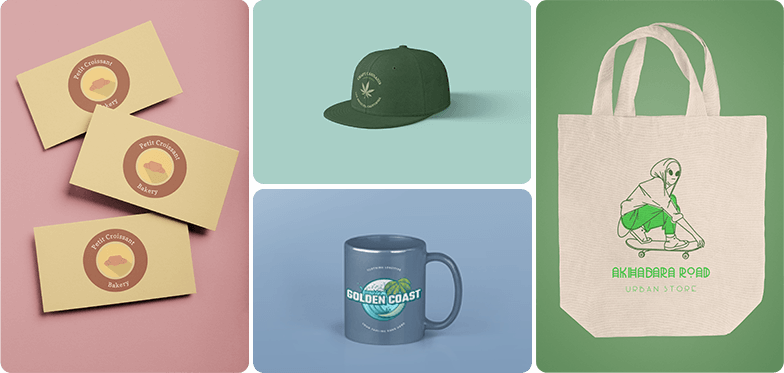
We live in the digital age, but it takes more than just using your logo online to get your brand noticed. You also have to get out in the real world. This is why we’re here to help you learn how to print a logo on everything, from apparel to marketing materials.
Strap in and prepare to learn how to customize all your branding assets with your logo, and remember, you can always bookmark this post and come back to it as often as you need!
What You’ll Learn in This Post:
- Logo File Types and Variations You’ll Need for Printing
- How to Print a Logo on Apparel
- Print Branded Stationery
- Put Your Logo on Packaging
- Promote Your Brand With Custom Marketing Materials
- Print Your Logo on Signs and Announcements
- Final Thoughts
Logo File Types and Variations You’ll Need for Printing
Before you run to the print shop with your logo saved on a USB, make sure you have the right type of file.
You don’t want a pixelated logo or one that blends into the background, so definitely take the time to ensure you have exactly the files you need to get the result you want.
Before running to the print shop or ordering customized items online, check these items off your QA list:
- Recommended file type: A vector format logo is a must when printing anything from apparel to paper goods. There are a couple different vector formats (SVG and EPS) that you can use, so double-check with your printing service to see what they prefer. The reason you want a vector is that this type of image file won’t lose quality no matter how big or small you stretch your logo design. There won’t be any distortion, pixelation, or loss of quality at any size.
- Color palette: Before printing hundreds of items, make sure your logo is legible and stands out against the background of the item it’s being printed on. You may find that you need to change your logo to a black and white design for certain items or that items with certain background colors don’t work well with your logo design. Run some tests before you commit to anything.
- Transparent background: A transparent logo (a logo with no background color) will look better than one with a solid background, especially when it’s being printed on items. The transparency gives it a cleaner and sharper look that makes the printing look more seamless overall. Use a transparent logo maker to ensure you don’t struggle to remove the background later on.
- Logo variations: It’s common practice for brands to have logo variations since your primary logo may not work on everything. Your combination mark may be too large for some items, so you can opt to use a wordmark or pictorial mark for smaller items.
⚡️ Get even more logo design tips that’ll make your brand stand out in our complete logo design guide!
How to Print a Logo on Apparel
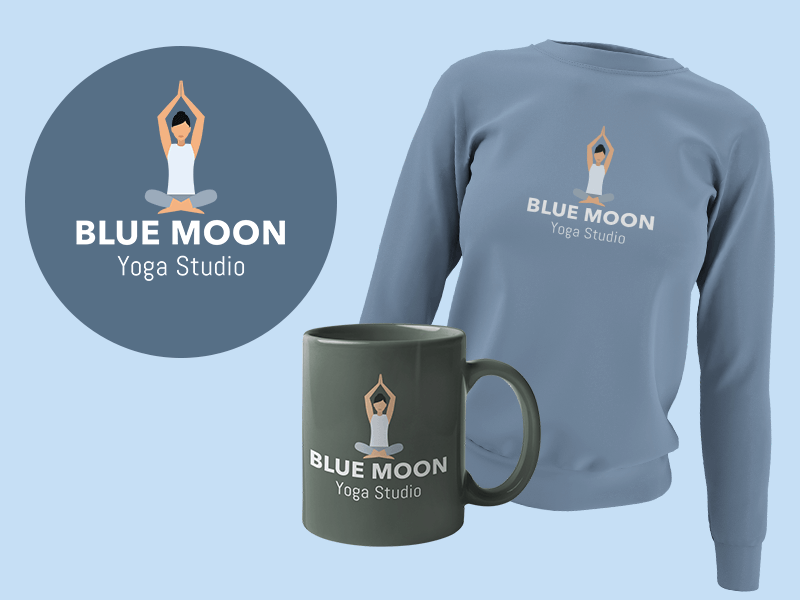
Whether you want to print custom company shirts or branded apparel for your shop, you’ll come across many printing options.
Not only will you have a huge range of apparel options to choose from, but you will also have to choose the right printing technique for the finish you want. The ideal printing technique can depend on factors such as the number of colors in your design, the fabric of the apparel you’re printing on, and the finish you want.
Take your time figuring this out and ask for samples before committing to a large order.
Some of the most common printing methods include:
Embroidery
This isn’t exactly a printing technique since your logo will actually be stitched into a shirt. This sounds complicated, but with the technology available today, it’s quite easy.
Your logo is uploaded into software that a stitching machine uses to embroider your logo onto a shirt or other item.
This is a great option for thicker fabrics and can give a more polished and professional look. You’ll often see embroidery on polo shirts, caps, jackets, and more durable items.
✨ Don’t miss our newest print-on-demand embroidery blog! 🌟 Level up your skills and become a POD superstar this year! 🧵✨
Screenprinting
This is one of the most well-known t-shirt printing methods around, so it’s no surprise that it’s also one of the most popular.
Stencils and ink are used to press the ink into the fabric of the garment. Since the inks used for this technique are thicker than in other techniques, the colors tend to be more vibrant and have a longer lifespan. This method is ideal for high-volume orders and won’t cost you an arm and a leg.
T-shirts are often screen printed along with sweatshirts, hoodies, and bags.
Heat Transfers
This method involves printing your logo onto sheets of transfer material that then get pressed onto the garment. The logo design is basically heated and pressed into the garment, securing it onto the item.
The transfers can peel off garments and crack after some use, so talk to your printer if you have concerns.
There is more than one heat transfer method to choose from. You can choose from dye-sublimation printing, plastisol transfers, and CAD cut heat transfer printing. Each has its own advantages, so be sure to learn more about these t-shirt printing methods before making your final choice.
DTG Printing
Direct to garment printing is a great option for printing if you have a more complicated logo design. This option allows you to print even the smallest of details that can be harder to accomplish with techniques like screenprinting.
DTG printing machines inject the ink right into the t-shirt, meaning it won’t sit on top of it. Although your design won’t crack, the colors can fade over time. It’s also best to use 100% cotton items or as close as you can get to that for the best results.
This type of printing is great for smaller orders, but won’t be ideal for huge bulk orders.
Now that you know more about the different printing options available for apparel, you’re better equipped to make the right choice. Even so, run some tests with your logo size, location, and printing methods before putting in your order.
💡 Check out Placeit’s apparel mockups and use them to visualize what you want your finished product to look like.
Print Branded Stationery
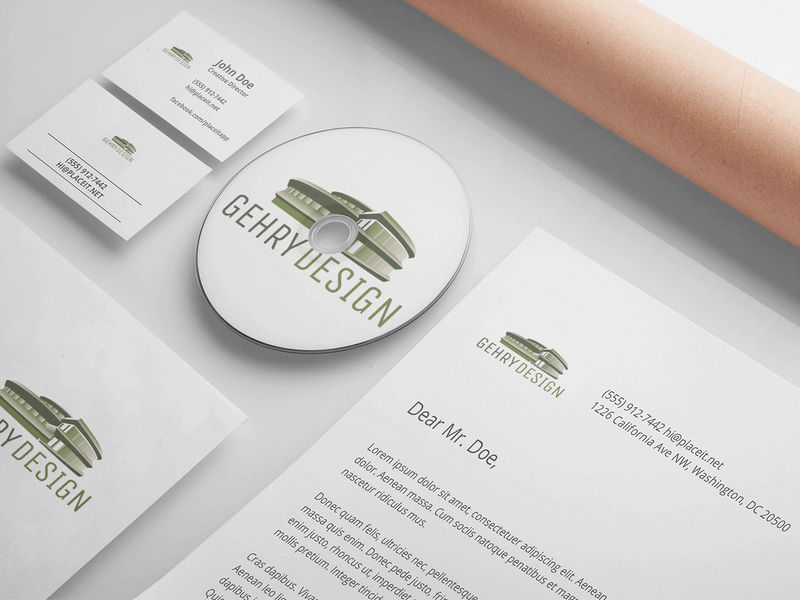
To give your brand more professionalism and legitimacy, create branded stationery using your logo.
Since we’re talking about printing on paper, you don’t have to do much research on what type of printing is best. Most of your work will go into figuring out the best logo placement and size to use.
These two factors will depend on what you’re printing your logo on. Some of the most common stationery items businesses use are letterheads, business cards, and envelopes. Use a transparent logo design for all of these items and ensure that your logo looks good over whatever color paper you’re printing on. This is often white, so be sure you have a logo variation that looks great on a white background.
Work with your design team when sizing your logo down for a business card. Be sure to have a logo variation that will look great in this size.
When putting your logo on a letterhead, be sure to leave plenty of space in the margins.
Always test your designs before making a large order. Play around with margin sizes, colors, placement, and logo size to get the perfect design.
✨😊✏️ You might like reading How to Start a Stationery Business in a Pen-Tastic Way
Put Your Logo on Packaging
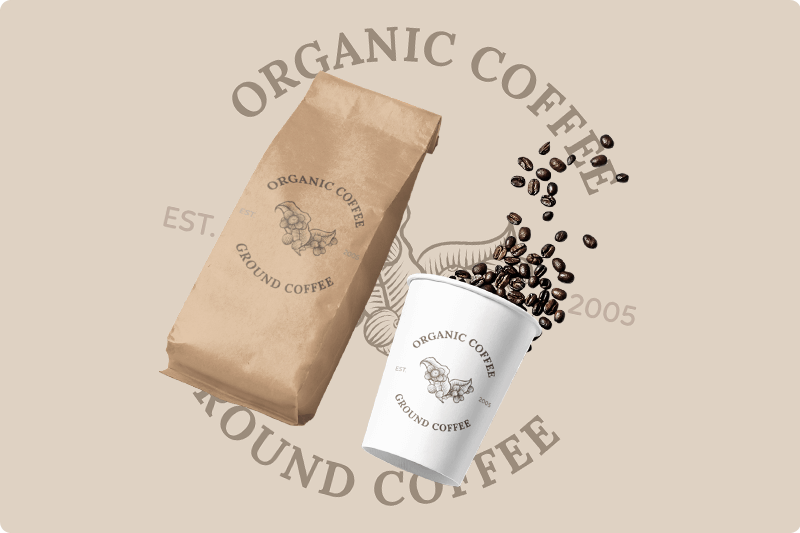
Branded packaging is a must for businesses that sell goods. Whether you sell apparel, food, beauty products, or anything else, look into custom packaging that will help your brand stand out.
Custom packaging featuring your logo design and color palette helps to establish your brand and makes it memorable. Customers will associate the products they love with your brand, helping them become develop brand loyalty.
Add your brand’s personality to create packaging your customers will be excited to see arrive on their doorstep. Some ideas for custom packaging include clothing tags, shopping bags, tissue paper, boxes, bottles, and labels.
Your logo design can change based on what sort of packaging you’re customizing. Some items, like boxes, will only be available in a beige cardboard color, so you have to be sure you have a logo design that will pop on this background.
Promote Your Brand With Custom Marketing Materials
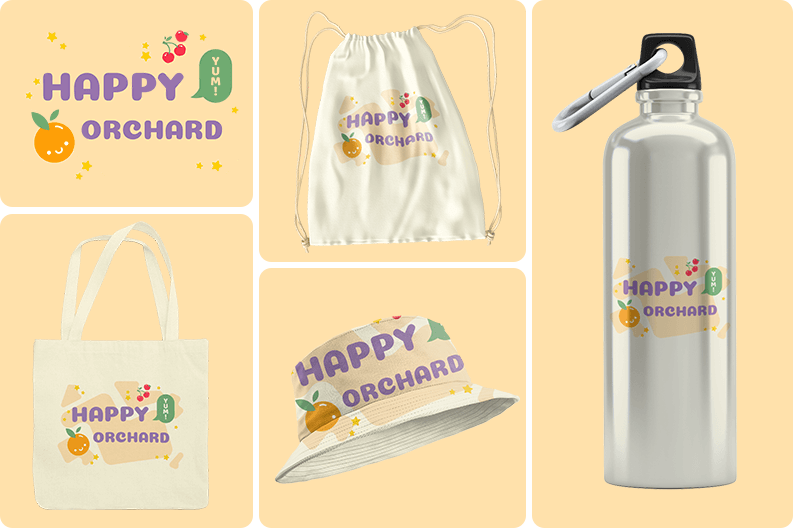
Promotional items are a great way to introduce your brand to new customers. And get them excited about it too!
If you’re putting together goodie bags for an event, be sure the items you plan to give away have your logo clearly on them. Items like pens may offer you a tiny printing area while bigger items like tote bags won’t limit you as much. Use your logo variations to find the best fitting one for each item.
Don’t print your logo on every item available in your provider’s catalog. Look for items that make sense for your brand and that will be useful to those interested in your brand.
Some of the most popular promotional items include tote bags, stickers, pens, mugs, water bottles, and pins. These vary in size, texture, color, and material, so various printing techniques and logo variations will need to be used to get it right. Think about how your logo may get warped on a rounded surface versus on a flat surface when choosing the right variation.
🤩 🌟 Want to know more? Learn how to make and sell stickers in a breeze with this easy-peasy guide!
Always run tests to ensure your logo is legible, clear, and recognizable. Having a vector format logo will be crucial here. This will make it easier for your printer to adjust the size of your logo without it losing quality.
Print Your Logo on Signs and Announcements
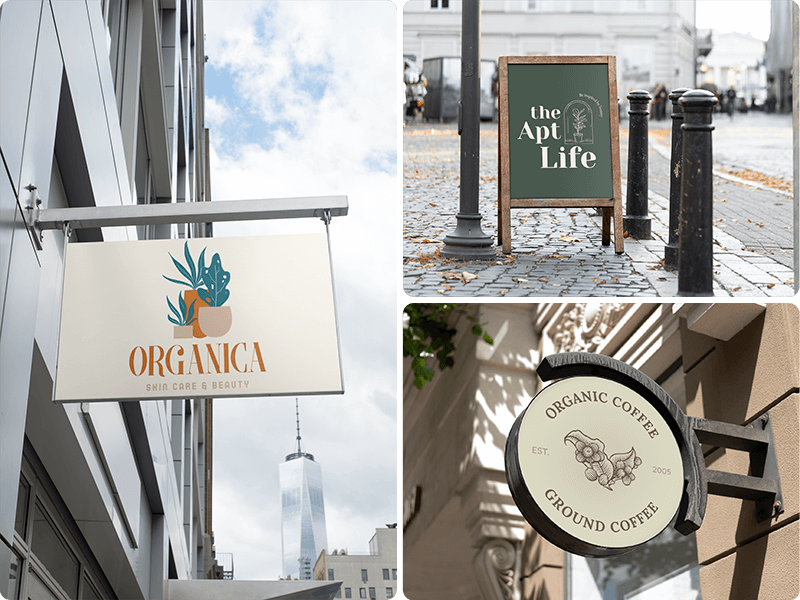
Finally, no matter what sort of business you have, signs and announcements will help draw attention to your business.
Signage is an absolute must for brick-and-mortar locations, especially if you have a restaurant or shop. These will make your location easier to find and identify. Billboards, mupis, and signs may be part of your plans as well. These will need to include your logo so that spectators recognize your brand and interact with it. Other items you may print your logo on include banners, posters, and ads.
For all of these items, a transparent vector is a must. This will allow you to infinitely increase the size of your logo without it getting pixelated or losing smaller details.
Your logo won’t be the only thing on the billboard or banner, so try your best to keep the design simple and bold.
To get your printed items just right, check out this ultimate guide for print sizes.
Final Thoughts
Printing your logo on just about anything is possible, and it isn’t hard to accomplish. Start with a great logo design and have the right file types and some logo variations on hand.
From there, it just takes some experimenting to get the look you want on each item you’re planning to print.
This can be an exciting part of growing your brand, so have fun with it. Don’t be afraid to ask for print tests and samples until you’re happy with the final product.
Let us know in the comments below what other items you plan to print your logo on ⤵️

1 Comment
link link
I thank you for the help in this question. At you a remarkable forum.